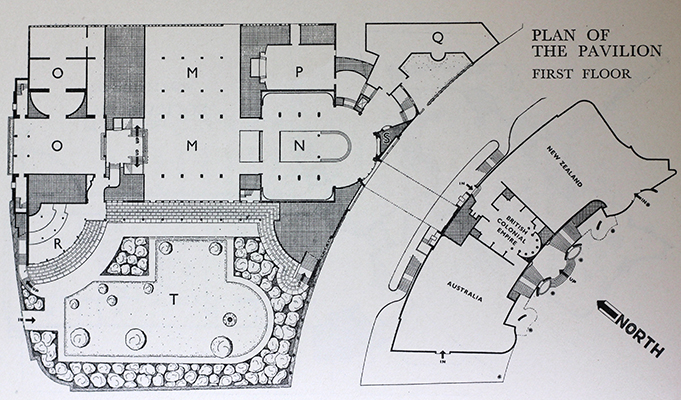From November 6 through January 19, 2015, the Lincoln Cathedral Magna Carta, one of four remaining originals from 1215 will be on display along with other rare materials from the Library’s rich collections to tell the story of 800 years of its influence on the history of political liberty. This is the first installment in a series of posts tracing the journey of the Lincoln Cathedral Magna Carta in the United States during its debut visit in 1939 until its return to England in 1946.

Magna Carta Hall in the British Pavilion. The Lincoln exemplification is encased in bullet-proof glass. [Photo from Guide to the Pavilion of the United Kingdom, Australia, New Zealand, and the British Colonial Empire by the United Kingdom Department of Overseas Trade, 1939. Content in the public domain.]
As the United States emerged from the Great Depression, a group of New York businessmen conceived of an exposition that would introduce Americans to the “world of tomorrow.” On April 30, 1939, the New York World’s Fair opened in Flushing Meadows, just outside New York City. The massive undertaking cost over $150,000,000 (the equivalent of approximately $2 billion in today’s dollars). Construction lasted four years and resulted in a small development of over 1200 acres. The Trylon and Perisphere symbolized the modernistic direction of the Fair’s message. Exhibitions on innovative products, manufacturing processes, and services gave fair-goers a glimpse of an optimistic future.
Approximately 60 foreign nations were represented at individual country pavilions and at the collective Hall of Nations. The impressive structure of the Pavilion of the United Kingdom, Australia, New Zealand and the British Colonial Empire stood just on the edge of the Lagoon of Nations. The World’s Fair organizers invested in the construction of the buildings but left the decoration and outfitting of interior spaces to the respective country’s architects and artists. Some of the artists who helped to beautify the British Pavilion included Eric Ravilious (who also designed the cover art for the official guide to the British Pavilion), Ernest Michael Dinkel, Marjorie V. Duffell, and Frank O. Salisbury.

Magna Carta Hall is designated by the “N” in the middle of the diagram. [Photo from Guide to the Pavilion of the United Kingdom, Australia, New Zealand, and the British Colonial Empire by the United Kingdom Department of Overseas Trade, 1939. Content in the public domain.]
A second-floor, outdoor walkway joined the south building to the north building, which housed the United Kingdom’s main exhibitions. Visitors found Magna Carta Hall on the first floor (see “N” on the diagram). The Lincoln Cathedral’s exemplification of Magna Carta stood encased in bulletproof glass at one end of the hall. Security guards flanked the document at all times. (Despite the tight security, a time bomb disguised as a portable radio was discovered in the British Pavilion on July 4, 1940. The bomb was removed to an open field elsewhere on the fairgrounds, but it unfortunately detonated, killing the two detectives assigned to disarm it.)
The World’s Fair was created to take visitors far away from the recent grim realities of war and economic instability and show them a future full of hope and prosperity. The 1939 season, however, opened just weeks after Germany’s seizure of Czechoslovakia, creating a parallel chaos in the Fair’s microcosm as the pavilion for the newly-invaded country went unfinished. In the next post, we will see the effects that the increasing world tensions had on the Lincoln Magna Carta’s maiden tour of the United States.
